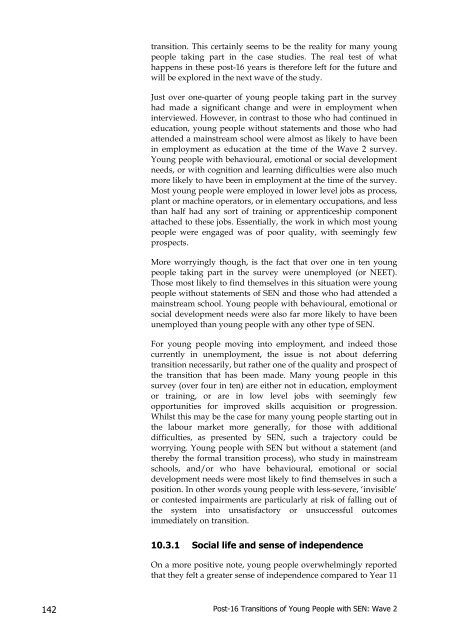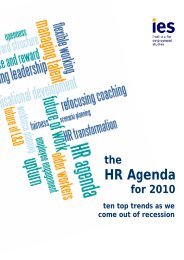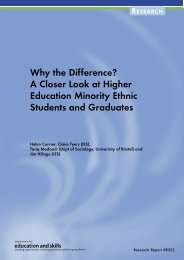Post-16 Transitions: a Longitudinal Study of Young People with ...
Post-16 Transitions: a Longitudinal Study of Young People with ...
Post-16 Transitions: a Longitudinal Study of Young People with ...
Create successful ePaper yourself
Turn your PDF publications into a flip-book with our unique Google optimized e-Paper software.
transition. This certainly seems to be the reality for many young<br />
people taking part in the case studies. The real test <strong>of</strong> what<br />
happens in these post-<strong>16</strong> years is therefore left for the future and<br />
will be explored in the next wave <strong>of</strong> the study.<br />
Just over one-quarter <strong>of</strong> young people taking part in the survey<br />
had made a significant change and were in employment when<br />
interviewed. However, in contrast to those who had continued in<br />
education, young people <strong>with</strong>out statements and those who had<br />
attended a mainstream school were almost as likely to have been<br />
in employment as education at the time <strong>of</strong> the Wave 2 survey.<br />
<strong>Young</strong> people <strong>with</strong> behavioural, emotional or social development<br />
needs, or <strong>with</strong> cognition and learning difficulties were also much<br />
more likely to have been in employment at the time <strong>of</strong> the survey.<br />
Most young people were employed in lower level jobs as process,<br />
plant or machine operators, or in elementary occupations, and less<br />
than half had any sort <strong>of</strong> training or apprenticeship component<br />
attached to these jobs. Essentially, the work in which most young<br />
people were engaged was <strong>of</strong> poor quality, <strong>with</strong> seemingly few<br />
prospects.<br />
More worryingly though, is the fact that over one in ten young<br />
people taking part in the survey were unemployed (or NEET).<br />
Those most likely to find themselves in this situation were young<br />
people <strong>with</strong>out statements <strong>of</strong> SEN and those who had attended a<br />
mainstream school. <strong>Young</strong> people <strong>with</strong> behavioural, emotional or<br />
social development needs were also far more likely to have been<br />
unemployed than young people <strong>with</strong> any other type <strong>of</strong> SEN.<br />
For young people moving into employment, and indeed those<br />
currently in unemployment, the issue is not about deferring<br />
transition necessarily, but rather one <strong>of</strong> the quality and prospect <strong>of</strong><br />
the transition that has been made. Many young people in this<br />
survey (over four in ten) are either not in education, employment<br />
or training, or are in low level jobs <strong>with</strong> seemingly few<br />
opportunities for improved skills acquisition or progression.<br />
Whilst this may be the case for many young people starting out in<br />
the labour market more generally, for those <strong>with</strong> additional<br />
difficulties, as presented by SEN, such a trajectory could be<br />
worrying. <strong>Young</strong> people <strong>with</strong> SEN but <strong>with</strong>out a statement (and<br />
thereby the formal transition process), who study in mainstream<br />
schools, and/or who have behavioural, emotional or social<br />
development needs were most likely to find themselves in such a<br />
position. In other words young people <strong>with</strong> less-severe, ‘invisible’<br />
or contested impairments are particularly at risk <strong>of</strong> falling out <strong>of</strong><br />
the system into unsatisfactory or unsuccessful outcomes<br />
immediately on transition.<br />
10.3.1 Social life and sense <strong>of</strong> independence<br />
On a more positive note, young people overwhelmingly reported<br />
that they felt a greater sense <strong>of</strong> independence compared to Year 11<br />
142<br />
<strong>Post</strong>-<strong>16</strong> <strong>Transitions</strong> <strong>of</strong> <strong>Young</strong> <strong>People</strong> <strong>with</strong> SEN: Wave 2

















